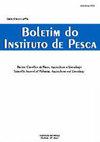在巴西伯南布哥州圣克鲁斯海峡捕获的大西洋线鲱鱼(Opisthonema oglinum)的长度结构分析,使用广义加性模型对其位置、规模和形状进行分析
IF 0.6
4区 农林科学
Q4 FISHERIES
引用次数: 1
摘要
大西洋线鲱鱼(Opisthonema oglinum)是圣克鲁斯海峡最常见的沙丁鱼,它位于巴西伯南布哥州的北部海岸。该物种在海洋中度过其生命周期的一部分,并在战略时刻进入河口。它的高度开发和对运河周边城市经济的重要性使我们反思需要进行调查,以促进可持续捕鱼,并更好地了解其在该地区的行为。本文采用广义加性模型对样本的位置、尺度和形状进行了估计,并对影响样本长度格局的因素进行了探讨。在雨季发现了较大的个体,并且在通道的中南部地区更集中。较小的沙丁鱼集中在博塔弗戈河的出水口附近,这是一个红树林覆盖面积较大的次级河道区域。很少有成虫进入海峡,绝大多数捕获的标本都是幼鱼。因此,探索至少达到性成熟的标本将是相关的,因为捕获年轻个体可能导致物种可持续性的不平衡。本文章由计算机程序翻译,如有差异,请以英文原文为准。
Length structure analysis of the Atlantic thread herring (Opisthonema oglinum) captured in the Santa Cruz Channel (Pernambuco, Brazil), using generalized additive models for location, scale and shape
The Atlantic thread herring (Opisthonema oglinum) is the most common sardine in Santa Cruz Channel landings, which is located on the Northern coast of Pernambuco state, in Brazil. The species spends part of its life cycle at sea and enters estuaries at strategic times. Its high exploitation and importance to the economy in the municipalities surrounding the channel led us to reflect on the need for investigations to promote sustainable fishing and a better understanding of its behavior in that place. In this study, the standard length of the specimens was estimated using generalized additive models for location, scale, and shape, and the factors that drive the length pattern along the estuary were discussed. It was identified the presence of larger individuals in the rainy season and greater concentration in the Center-South region of the channel. The smaller sardines were concentrated near the outflow of the Botafogo River, an area of secondary channels with greater mangrove coverage. Few adults enter the channel and the vast majority of specimens captured were young. Thus, it would be pertinent to explore specimens that have at least reached sexual maturity, since the capture of young individuals can cause an imbalance of species sustainability.
求助全文
通过发布文献求助,成功后即可免费获取论文全文。
去求助
来源期刊

Boletim do Instituto de Pesca
FISHERIES-ZOOLOGY
CiteScore
0.80
自引率
0.00%
发文量
24
审稿时长
>12 weeks
期刊介绍:
To publish original articles of research and short communications in the following áreas: Fisheries, Aquaculture, Zootechnology, Limnology, Oceanography, Biology and Pathology of aquatic organisms. The publication depends on the approval of the Editorial Board, based on the peer review.
 求助内容:
求助内容: 应助结果提醒方式:
应助结果提醒方式:


